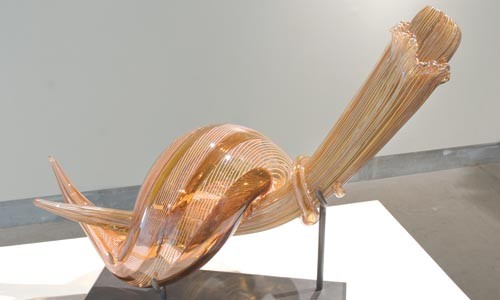In Pittsburgh's 250th-anniversary year, much attention has been given to its industrial beginnings. But remembrance of the hard-living, skin-blistering mill experiences that defined the lives of so many has taken a backseat to the exploration of what the city has become since it was identified as one of America's principal (if soot-stained) economic keystones: that is, a burgeoning center for the arts.
Now on view in the Hodge Gallery at the Pittsburgh Glass Center is Glass and Steel: Art Transcends Industry, curated by PGC assistant director Heather McElwee. The show is a prime example of how the city's economic building blocks have become vital to its redefinition as a cultural, rather than industrial, center.
One exhibition stand-out is Jeffery Phelps' five-paneled, mixed-media work "On a Clear Day," which features a painting of the Pittsburgh cityscape from a riverbank. Distorted by overlying, vertically cut strips of fused glass, the panorama becomes vaguely three-dimensional, making the river appear to move and buildings wink with reflected light. The five metal arches projecting from each panel, and the dramatic shadows they cast, cleverly reference two of Pittsburgh's traditional transportation modes: train tracks and bridges. While the work's title references the city's capricious meteorological patterns, it also seems to allude to the 1965 musical about a reincarnated woman by Burton Lane and Alan Jay Lerner. It's a fitting reference, as Pittsburgh, too, is experiencing a kind of rebirth.
Perhaps unsurprisingly, decorative arts have a conspicuous presence in this show. Dan LeDonne's decorative dividing screen of kiln-cast glass discs and heavy steel arcs, part of his "Screen Series (No Boundaries)," has the strong geometry of Bauhaus design. Bill Ballard's "Burgh Buds," composed of glass, steel and copper, have the stylized curvature and anthropomorphic floral character of Art Deco. Nick Russo, Daneal Ferraro and Doug Hansel pay homage to the god of wine with their colossal grape-cluster chandelier "From the Arbors of Dionysus," made of blown glass spheres mounted on a conical metal armature.
Another slyly eloquent work is Jonathan Capps' solid sculpted-and-blown-glass "Subtle Serpent: The Fruit Tastes Good," which is held aloft on a steel armature and vaguely recalls Brancusi's anthropomorphic abstractions. Capps' deft articulation of evil's insidious qualities appears in both the work's languorous beauty and its vine-like grasp, which spirals poetically (but decisively) around what might be read as the fruit offered by the archetypal snake. But its abstraction dissembles, as evil often does.
Theresa Cress' lamp-worked, glass-and-steel necklace "My New World Awaits!" is a wonderful, cartoonish ode to sci-fi, with knotted-wire planets and glass ray-guns, from which orange and yellow beads radiate like electron beams.
Other works are politically conscious. "Desired Effect," a ceremonial mace, also of lamp-worked glass and steel, by Darlene Durrwachter Rushing and Jan Loney, is based on a weapon originally designed to fracture skulls. Asking viewers to consider the cost of "progress," they cite the decimation of the local Native American population in 1763, when the Pittsburgh militia gave blankets infected with smallpox to Chief Pontiac's tribe. The glass head of Rushing and Durrwachter's mace has been refashioned to resemble the microscopic cell structure of the smallpox virus.
Social consciousness and aesthetic intrigue aside, what is most heartening about this exhibition is that it reveals art to be -- like the urban pioneer -- a genuine catalyst for revitalization. Yet, the show also points to a larger (and somewhat frightening) national trend: It is a beautiful eulogy to industrial self-reliance. As America continues migrating from the self-sufficiency that helped make it a world power, it approaches what Business Week has dubbed "The Creative Economy," where intangible ideas, not physical objects, are both product and asset. While this suggests an exciting future, studded with possibilities, our vanishing industrial base also indicates an alarming national vulnerability in the global game of economic Monopoly.
Glass and Steel: Art Transcends Industry runs through Sept. 5. Pittsburgh Glass Center, 5472 Penn Ave., Friendship. 412-365-2145


